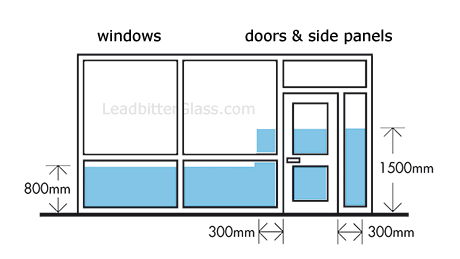Safety Glass Regulations
NOTE: We do not give out general advice regarding safety glass locations unless you are buying decorative glass from us. Please do not call us seeking general advice regarding safety glass.
Safety Glass Regulations cover what types of glass can be installed into windows, doors and other glazing locations. Here is our guide to help you understand where you must look to install the correct safety glass to your home or business.
To comply with the Building Regulations glazing requirements or also known as ‘Critical Locations’ there must be safety glass or safety guards in place to protect people from injury. The most likely locations for accidents caused by glass breakage, which could result in cutting and piercing injuries are in doors, door side panels, low windows and low level glass in walls and glass partitions.
Safety glass should be fitted in all doors and other windows or glazed areas that are lower than 800mm from the floor level. Glass panels less than 250mm wide can be fitted with 6mm glass or laminated glass instead of toughened glass.
Every decorative glass panel our studio creates is toughened safety glass as standard. View our galleries to see what can be achieved with toughened safety glass.
Critical Locations are considered to be:
1. Glazing in doors – Glass which is wholly or partially within 1500mm from floor level. As the drawing below shows, any glass in doors that does not start over 1500mm from the floor must be safety glass.
2. Glazing adjacent to doors – Windows/side panels wholly or partially within 300mm of the edge of a door and which is also wholly or partially within 1500mm from floor level must be safety glass.
3. Low Level Glazing – Not covered in (1) OR (2) ABOVE – Other glazing that is wholly or partially within 800mm from floor level. This means that windows that are not located within 300mm of a door must use safety glass if the bottom of the glazing is within 800mm of the floor level.

Glazing in ‘Critical Locations’ should either:
1. Break safely, if it breaks, i.e. laminated or toughened Class C safety glass complying with BS6206. Or if it is installed in a door or in door side panels and has a width or height exceeding 900mm it should be Class B of BS 6206. These requirements do tend to change and it may also be stamped with an EN number.
99% of the glass you’ll find in our Past Works galleries will be toughened safety glass. It only won’t be if a customer has specifically requested that we use a different type of glass. Whether it’s etched, leaded, bevelled or fused glass, you’re sure to find something stunning in our galleries for your home’s windows and doors that meets all your safety requirements.
Please note:
• Ordinary wired glass is not safety glass.
• For double-glazed sealed units, the rules apply to both pieces of glass.
• All safety glazing should be permanently marked in accordance with BS6206. The markings should be still visible after the glass has been fitted and the beading and pointing has been completed.
The most common form of safety glass (and the lowest cost) is 4mm toughened glass. This glass is used for almost all residential safety glazing and 4mm toughened comes in a large range of obscure patterns as well as the energy saving glass – Pilkington K glass.
Normal glass (annealed) can also be used as a safety glass in some instances as long as the glass is thick enough. As an example 6mm annealed glass can be used in doors up to a glazing width of 250mm but must not exceed 0.5sq.metre in area.
Other annealed glass regulations are as follows…
8mm glass can be used as safety glass if it does not exceed 1100mm in any direction
10mm glass can be used as safety glass if it does not exceed 2.25m in any direction
12mm glass can be used as safety glass if it does not exceed 3.0m in height or 4.5m in width
15mm glass can be used as safety glass in any size opening
Disclaimer
The tips and advice on this page are just a helpful insight in to the selection of safety glass glazing. Leadbitter Glass does not accept any responsibility if you are injured or suffer loss – financial or otherwise by following our tips, advice or information on this page. To be 100% sure of the of the correct type of glass required for your project, contact your local building regulations department to obtain the most up to date and correct information regarding safety glass.




